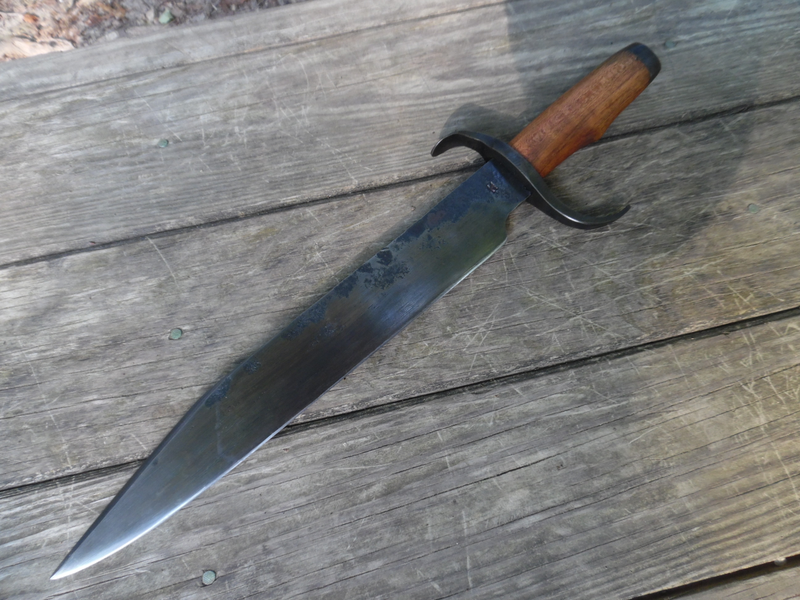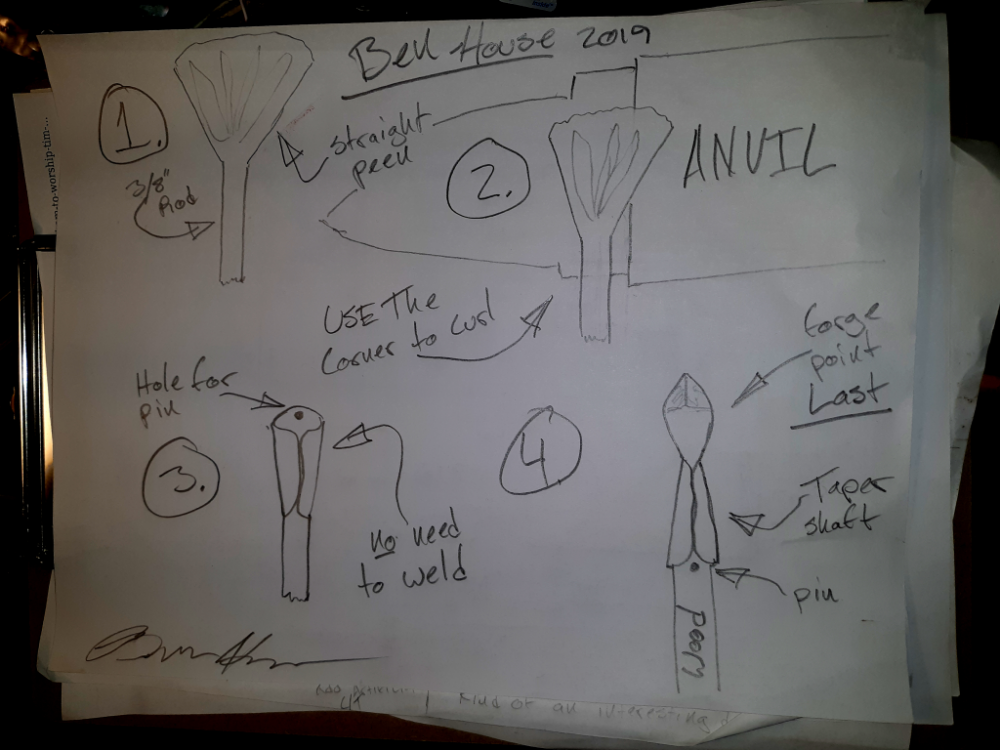-
Posts
159 -
Joined
-
Last visited
Content Type
Profiles
Forums
Articles
Gallery
Downloads
Events
Everything posted by Rhyfelwr
-

Brass melting or burning ?
Rhyfelwr replied to BartW's topic in Smelting, Melting, Foundry, and Casting
I smelt and cast rifle and pistol brass into knife guard shapes and then file and grind to finish. .45 brass is my favourite. I usually just put an iron cup on the forge and cram it full of brass shell casings. A pinch or two of borax and heat to liquid, add more shells as needed. I have a guard shaped dimple carved in my concrete floor near the forge for a mould. Sometimes there will be a touch of green smoke, but it goes away quickly. I make sure to not have many contaminates in the brass because once I had water in some that I threw in the pot and the water became steam instantly and the popping wasn't fun.. -

What's your latest blade look like? Post em and let us see.
Rhyfelwr replied to HondoWalker's topic in Knife Making
Hound that blade has some very clean lines. Just about perfect drop also, I never liked Kukuri style blades with to much forward drop. Nice -

What's your latest blade look like? Post em and let us see.
Rhyfelwr replied to HondoWalker's topic in Knife Making
Thanks. -

What's your latest blade look like? Post em and let us see.
Rhyfelwr replied to HondoWalker's topic in Knife Making
Some of the 1.75" rod he gave me is pure iron. I told him the blade was shaving sharp, but it probably wouldn't hold up for long under working conditions. The fellow ended up hanging it on the wall in his office. I used some of the iron to forge a camp axe head with a file steel bit. It was interesting, I don't forge much true iron, kinda hard to get nowadays. -
I use brass rod, or #6 copper ground wire..The copper makes an excellent handle rivet, it upsets easily and files and grinds well. And its strong enough for almost any handle, if it is counter-sunk properly and snug. Once you are done peening the head out, you can file or grind it flush.
-

What's your latest blade look like? Post em and let us see.
Rhyfelwr replied to HondoWalker's topic in Knife Making
This is one of my most recent commissions, the blade is forged from a piece of water tower. The client wanted this knife made from the steel even after I advised him that it was medium carbon. It was a retirement gift for a friend in the waterworks. I also built a wooden plaque that it hangs on with the water tower wood-burnt into it (he provided a picture). Blade is medium carbon, guard and butt-cap are the same. They are blued and I used Cherry for the handle. -

Beam Hammer- Has anyone built one!
Rhyfelwr replied to Greebe's topic in Power Hammers, Treadle Hammers, Olivers
Looks stout. -
Beautiful work, I love the shape of the blade. Here lately the trend has been to make the forward curve to strong and you've made this just right.
-
My boys run off with them.
-

Forging Arrow Heads
Rhyfelwr replied to DevanMcDavitt's topic in Spears, Arrows, Pole arms, Mace/hammer etc.
I have made several arrowheads, broad heads and field points. I forge them with a socket. Then I drill the end of a socket and put a pin in it. The process goes something like this: I use 3/8" rod stock, I begin forging out the skirt and when it gets a bit flat and belled out I switch to a straight peen hammer. The goal is to thin and spread the metal on the outer edge more than at the neck. Man I should just film a demo. This is hard to explain. Once you have the skirt spread out to .... I'm gonna post a drawing. Easier. Oh and I use a simple tapered drift to round it out a bit as needed. -
Looks good for a first, is it a spike? If it is you may want to try some spring steel for better edge retention and toughness. So the questions, what steel? Heat treat? What wood? Is it glued up or are the pins peened?
-

Touchmark register
Rhyfelwr replied to philip in china's topic in The Business Side of Blacksmithing
I know years ago I considered using a Runic 'H' and then I ran across Helm Forge using it and just decided to go with a simple H. I make my own letter punch so every five or six years it changes slightly due to wear and tear. I just realized that the last post on the original thread was mine, it was 10 years ago this December. Man time flies. -
Very nice! Makes me want to go make a new grinder myself.
-
I don't know about the bending rather than the snap thing, I've snapped the claws off of a 4' nail pulling bar and if the texture of the break was anything to judge the temper was near perfect and hard as glass or nearly anyway. You sacrifice wear on the claws for toughness. And as for temper colors I straw temper most of my knives, sometimes deep straw. And the choppers hold well and sharpen decently. And the axes that I've made in 1060 and 5160 that I tempered straw chop through cinder block alright, though the 5160 tends to be much more durable.
-
Have you tried hitting it on something relatively hard? Just to see if it wants to shatter? I know my favourite hammer as of the last ten years or so is a 22oz Estwing, I had a Vaughan California Framer that looked a lot like your hammers. My experience with the Estwing is that they tend to err on the tough side. Meaning that the head deforms over time and the nail pulling end tends to wallow out after a while, but they don't break. Seems like there is a fine line in there. I have a book around here that tells the preferred temper color of a hammer head, just gotta find it.
-
Looks like a Vaughan style. My day job is as a Carpenter, and one thing I've been thinking of making is some framing hammers. They look good, the main thing with wood handled framing hammers is to have a large eye, thats a weak point. The only thing I see wrong with them is maybe taper the nail pulling side a little more consistently there are big nails and small, if its a gradual taper it'll fit them all. Also I'm curious how you hardened and tempered them, also what steel?
-

Heat treat fracture, or hammering too cold?
Rhyfelwr replied to Lar45's topic in Heat Treating Knives, Blades etc
It looks like heat cracking to me, my experience with after quench cracks tend to be almost clean snaps. But then I like simple steels. And I never adjust after a quench, when it comes out warped I re-heat and re-quench. Then I look at why it warped, too thin, heat uneven etc. -

Rusty hammer build along
Rhyfelwr replied to Jason Fry's topic in Power Hammers, Treadle Hammers, Olivers
Looks great, thanks for taking the time to document the process. I've planned for several years to build a similar setup, just working on getting the space in my shop. -
Looks great!
-

traditional Nepalese blacksmiths and forges.
Rhyfelwr replied to Gubilok tennerman's topic in Knife Making
I was thinking something similar. -
I came late to this discussion.. I don't do hourly, sometimes I think back over what I've made and figure it by the hour but I do not price jobs hourly. My full time job is as a Carpenter, I build houses and decks and work for myself. I try to never make less than $200-250 a day. And unless there is some deadline I don't work more than 8 hours a day 5 days a week. When I bid a job the client is required to pay for materials and I receive pay either on draws, or when the job is done depending on the size of the job. And the same goes for my blacksmithing business. No less than $200 a day, not counting materials, sometimes it will be many times $200 in a day. Also if there are any tools needed that will be semi expendable I just price them into the quote. So in summary: Shop rate: >$200/day + Materials. Semi-Pro.. (not quite a hobby, not quite my living) No overhead, except a little electricity. Maybe a few belts and wheels.. But hey, add them onto a job! My shop is next to my house. I've also learned not to be scared of pricing to high, I noticed people like to pay more for less. I think its because they wonder whats wrong with it if you are cheap.
-
Anybody actually use the tannic acid? I've got two quarts of distilled oak tannins, I might try it.
-
It looks like a blade preform for sure. It still looks plenty thick enough to forge the bevels in. Question though, what type of handle/guard are you going for?


